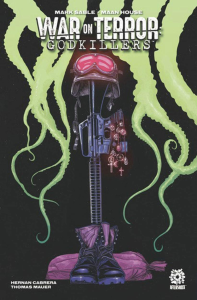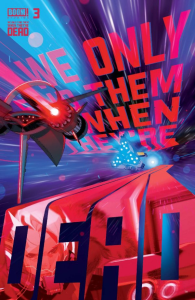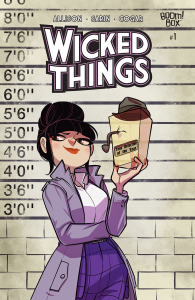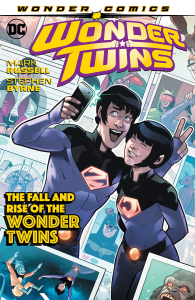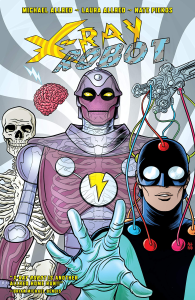If you read last weeks’ posts, you know what’s going on. Here is a final batch of 2020 comics worth tracking down…
WAR ON TERROR: GODKILLERS
Collecting a five-issue mini-series, Godkillers has the kind of ridiculous and ultimately tasteless premise that, when pulled off with an unashamed straight face, can make for a kickass ride: it follows Abdul Alhazred, an Arab-American folklore professor whose atheism is defied when he finds himself recruited by (as the back cover blurb puts it) ‘a special forces unit tasked with fighting insurgents who use mythological creatures as weapons of mass destruction.’ Like he had effectively done in 2011’s Graveyard of Empires, writer Mark Sable merges geopolitics with solid military fiction and supernatural horror, playing to the strengths of the two genres as he pits the Godkillers against both ISIS and gruesome demonic creatures.
Yes, there’s something discomfiting about the way the comic literalizes the notion of religious war, but you can spot a tongue lodged in its cheek, especially in the bits concerning the team’s Christian fundamentalist commander. The backmatter includes redacted memoranda sucking up to Trump while also explaining that with ‘the current turnover amongst National Security Advisors, I felt it best to take this directly to you rather than risk someone departing the administration and leaking details of the operation to the media.’ Without ever devolving into outright parody, the series posits a nightmarish world that could’ve sprung from the former president’s deranged rhetoric (even if it stops short of justifying a Space Force). It’s a world in which the mystical realm that fuels terrorism – as well as Islamophobia – turns out to be real, yet it has no sympathy for fanatics on either side… talk about having your cake and eating it too!
Artist Maan House and colorist Hernan Cabrera get in on the game, each providing the most deadpan approach to this blood-spattered thriller as it moves from Syria to the Philippines and beyond. We are not in Hellboy’s stylized universe, but in a reality that mostly resembles our own, which makes the presence of gods and monsters even creepier… If anything, Cabrera can be blamed for going too overboard with the dusky atmosphere, as his shadows sometimes make it hard to distinguish between the different members of the extensive cast.
WE ONLY FIND THEM WHEN THEY’RE DEAD
Another sci-fi spin on religion… and yet another deep space thriller. It’s not usually my favorite genre, but 2020 was an exceptionally strong year for the latter (or perhaps it just became too damn appealing for me to seek distance from our own collapsing planet). The first four issues of We Only Find Them When They’re Dead still managed to stand out, though, with their enticing premise: in the 24th century, there is a whole industry and lucrative trade developed around ships that strip-mine the corpses of dead gods floating around in space. We follow one of those crews, who ventures into uncharted territory.
For a tale with such an outrageous set-up, Al Ewing’s script is surprisingly committed to playing things straight. In the Isaac Asimov tradition of science fiction that exploits the contrast between cosmic concepts and small-scale logistics, We Only Find Them When They’re Dead is quite dialogue-driven, focused on a narrow group of characters, and concerned with their ship’s specific maneuvers. I wouldn’t go so far as to call it cerebral, but here is a comic for those who enjoy figuring out the rules of a world’s proto-science and then seeing the cast deal with the technical challenges the story throws at them. (For a much wilder take on the genre, check out Ewing’s ongoing run in Guardians of the Galaxy…)
WOFTWTD doesn’t look old-school, though. Simone Di Meo’s character designs wouldn’t seem out of place in a digital Disney cartoon and the coloring, assisted by Mariasara Miotti, is as aggressively blinding as the one in Far Sector. While I’m not in love with the visuals, the art does deserve some credit for successfully working around the fact that much of these earlier issues consisted of talking heads communicating at a distance, from separate compartments in the spaceship. This could’ve felt cold and static, but the dynamic page layouts – with a lot of skewed panel shapes – keep the energy flowing.
WICKED THINGS
The creative team behind the ultra-acclaimed Giant Days reunited for this parody of teen detective stories – a staple of young adult fiction that mines the open-minded curiosity and the arrogance of youth, both of which are here taken to amusing extremes. This new series stars former wonder sleuth Charlotte Grote, who is simultaneously a deductive genius and an easily distracted, hyperactive post-millennial. While attending an international award show for teen detectives, in London, she gets involved in a silly murder mystery (the joke being that the solution seems pretty obvious from the start), yet the story soon spirals into an entirely different direction, as Charlotte (sort of) joins forces with the British police to solve even more ludicrous capers…
Wicked Things nails its droll farce not only through the truly screwball pace and dialogues, but also through deft cartooning, including an endless parade of comedic expressions, character designs, and background details. Indeed, between John Allison’s witty one-liners, Max Sarin’s exaggerated drawing style, and Whitney Cogar’s cheery colors, there is not a single moment of filler in this comic, with every page packed with one funny panel after another. It was a delightful read every step of the way and I can’t wait for the next volume!
And speaking of brilliant teen comedies…
WONDER TWINS
Between Red Sonja and Second Coming, Mark Russell is quickly becoming a serious contender for Fred Van Lente’s place as the most reliable mainstream writer in terms of engagingly combining excitement, comedy, and political philosophy. If further proof was needed, 2020 gave us the final issues – and the second collected edition – of his surprisingly smart DC maxi-series, Wonder Twins.
Honestly, if it wasn’t for Russell, I probably wouldn’t have picked this up in the first place… Stephen Byrne’s art is serviceable, but not really to my taste, and I had no particular investment in the concept: alien teen siblings with silly super-powers (after fist-bumping, he turns to water while she can transform into animals) attending a high school on Earth. And yet, not only does Wonder Twins establish Zan and Jayna as genuinely charming – he’s disarmingly upbeat, she’s perceptively sarcastic – but it also uses the notion that they come from a utopia to shed light on our own planet’s stupidity and injustice (filtered through the DCU).
The first volume, Activate!, knocked it out of the park with its sharp satire of the private prison-industrial complex (here run by Lex Luthor), toxic masculinity (including Zan’s droll failure to conform to douchebro norms), and everyday racism (one of the villains was a white lady who kept using her magical cellphone against black people). This second book, The Fall and Rise of the Wonder Twins, wraps up the previous plotlines while further spoofing the exploitation of labor and cable news channels. The amazing thing is that all this takes the form of satisfying superhero tales which both follow *and* break the genre’s formulas, culminating in some of the best Trump-era jokes during the climax, when people rally behind a defective artificial intelligence seeking to return the planet to the eighties!
It takes a certain kind of genius to turn a brightly colored teen book about a couple of lame Hanna-Barbera characters from the 1970s’ Super Friends cartoon show into a subtly deconstructive piece, but Wonder Twins is especially effective at ridiculing the Justice League’s usual story resolutions (then again, nothing screams ‘adolescent’ more than arguing that grown-ups are wrong…). Sure, Russel has been doing a similar gesture in Second Coming, but that series deals with stand-ins for the DC cast, which removes some of the edge. As for his indie farce about ultra-rich capitalists, Billionaire Island, that too feels ultimately safer, aiming at easy targets whose caricature most readers are probably willing to mercilessly mock anyway. In turn, Wonder Twins amusingly exposes the disturbing side of beloved superhero properties to their very fans, which is a much more subversive gesture.
X-RAY ROBOT
If you’re already familiar with the wonderful collaborations of Michael and Laura Allred, you’ll be glad to know X-Ray Robot lives up to their previous work. If this is your first trip here, however, then get ready, because you’re in for a treat: this four-issue mini-series filters mind-bending science fiction through a surrealist sensibility in the story of a robotics laboratory that develops interdimensional travel. The protagonist is one of the scientists, who starts having confusing visions of other dimensions and is soon recruited by an alternate version of himself (from the future) to prevent the Ultimate Nihilist from destroying the fabric of reality!
Like in their Madman comics (which originate a neat cameo here), the combination of Michael’s psychedelic story and rubbery artwork with Laura’s flavorful colors results in something that often looks like a pop art extravaganza… Once again, the main reason this mini-series was not in my original list is that the collected edition only came out in January 2021!
It’s escapist fare, for sure, but it’s also an enthusiastic celebration of escapism itself. A flamboyant ode to upbeat Silver Age storytelling, X-Ray Robot pits ‘people of empathy, common sense, intelligence, creativity, and good will’ against ‘a soul so infinitely miserable that it not only despises mankind, but is intent on destroying all existence.’ If the comic has the same mission as its heroes, it certainly triumphs: reading X-Ray Robot is a sure way to put a goofy smile on your face.

